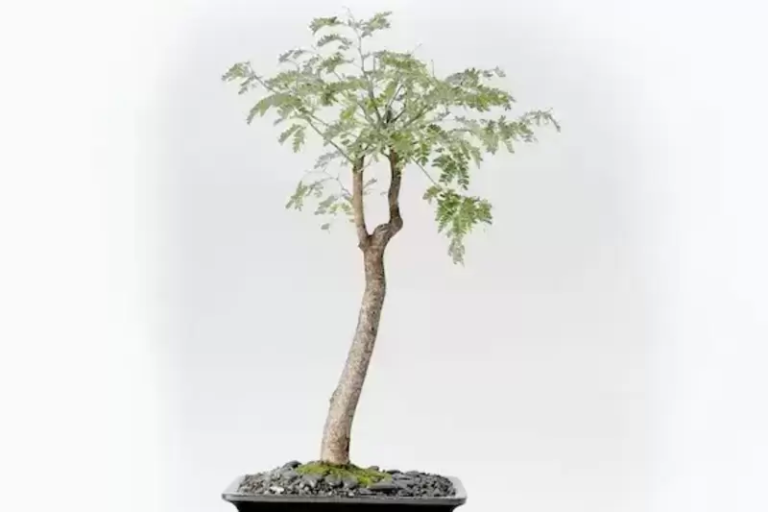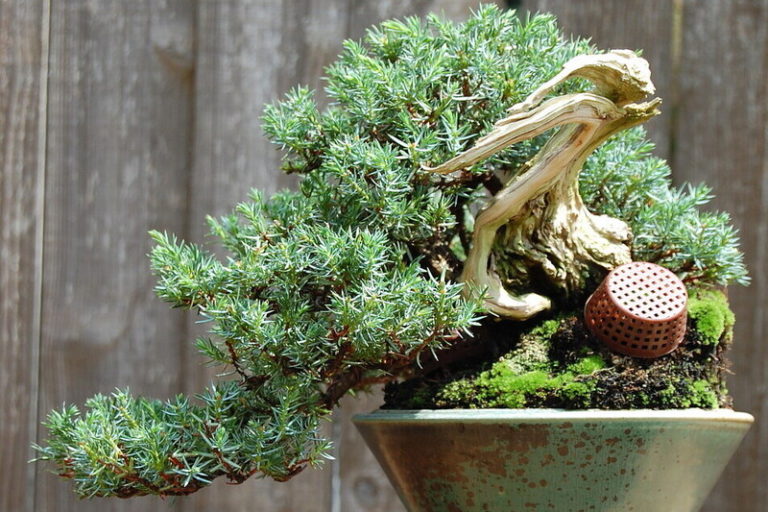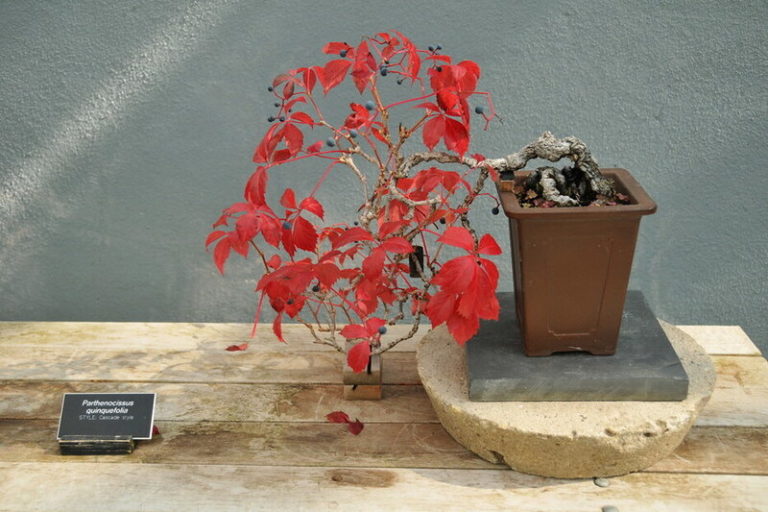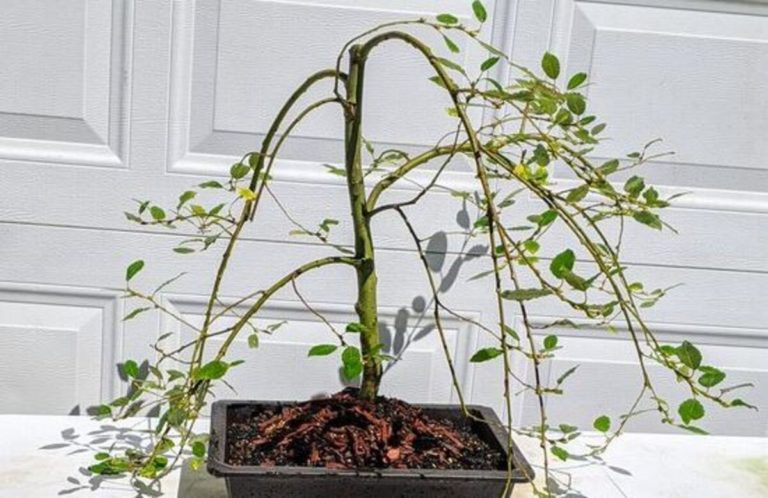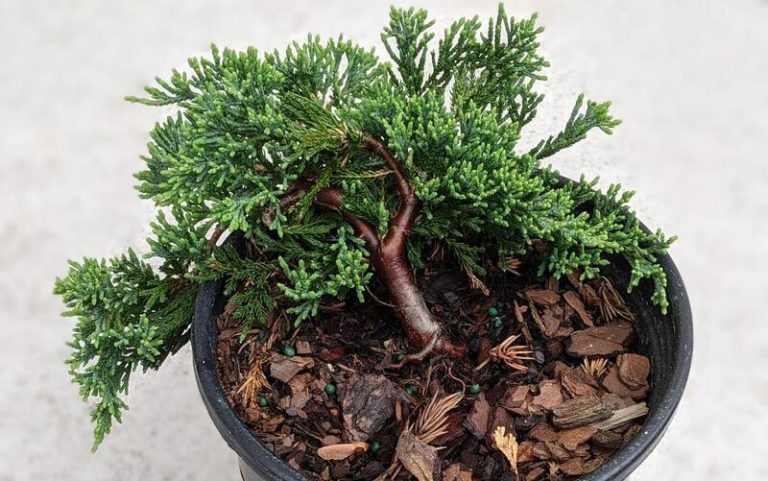Orchid Bonsai Trees: Captivating Living Art for Your Indoor Space
Orchid bonsai trees are stunning masterpieces that exhibit the amazing beauty of orchids in a compact and creative shape. These small miracles mix the beauty of orchids with the technique of bonsai, resulting in intriguing and delicate living sculptures. In this post, we will look at the world of orchid bonsai trees, their beginnings, maintenance suggestions, and the delight they provide to lovers.
What is an Orchid Bonsai Tree?
An orchid bonsai tree is a small and artistic representation of an orchid plant created using bonsai techniques. It captures the beauty of orchids in a compact form through careful cultivation, pruning, and shaping. Orchid bonsai trees showcase the delicate flowers, elegant foliage, and graceful growth patterns of orchids in a confined space. They require specific care and maintenance to ensure their health and aesthetics. Orchid bonsai trees are admired for their artistic value and the skill involved in their creation. They provide a unique way to appreciate and enjoy orchids in a miniature and manageable form.
History and Origins of the Orchid Bonsai Tree
The history and origins of the orchid bonsai tree can be traced back to the ancient art of bonsai itself, which originated in China over a thousand years ago. Bonsai, meaning “tray planting,” is the practice of growing and shaping trees or plants in containers to create miniature landscapes.
Orchid bonsai is believed to have originated in Asia, specifically China and Japan, where bonsai flourished. Due to their attractiveness and symbolic significance, orchids have been revered in these civilizations for centuries. As bonsai cultivation techniques advanced, devotees began experimenting with training orchids to become bonsai trees.
The popularity of orchid bonsai grew as a result of the unique challenges they presented. Orchids, with their delicate and intricate flowers, graceful foliage, and diverse growth habits, offered a new level of artistry and complexity for bonsai enthusiasts to explore. Orchid bonsai trees became a sought-after style within the bonsai community and were admired for their elegance and captivating aesthetics.
Over time, orchid bonsai techniques and knowledge spread to other parts of the world, gaining recognition and appreciation among bonsai enthusiasts globally. Today, orchid bonsai trees continue to be cherished for their artistic value and the skill required to cultivate and maintain them.
The history and antecedents of the orchid bonsai tree illustrate the art form’s continuous evolution and cross-cultural influence. They represent a fusion of ancient traditions with the beauty and allure of orchids, resulting in a singular and captivating miniature expression of nature’s beauty.
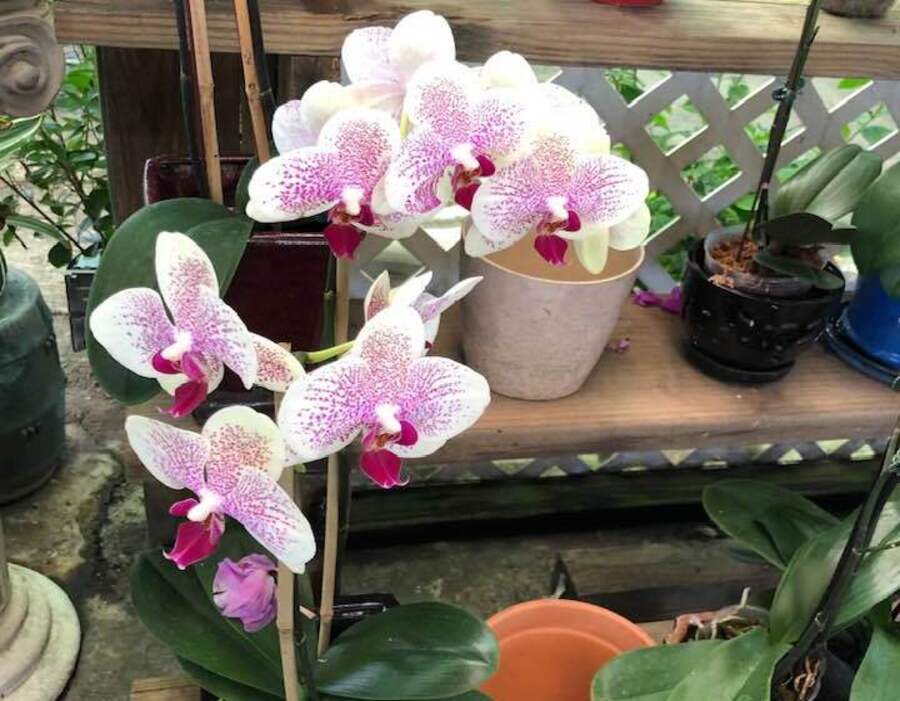
Types of Orchid Bonsai Trees
There are various orchid species that are often utilized for bonsai, each with its own distinct traits and beauty. Here are some common orchid bonsai tree varieties:
Orchid bonsai are particularly well-liked, and Phalaenopsis orchids, often called moth orchids, are a popular option. Their blooms remain for a long time and are both beautiful and varied in color and design. The large, leathery leaves and arching stems of a Phalaenopsis orchid are trademark features.
Dendrobium orchids are well-known for their varied forms, colors, and patterns. They have cane-like stems and can create stunning flower sprays. Because of their remarkable appearance and susceptibility to bonsai training, Dendrobium orchids are popular for bonsai.
1. Cymbidium Orchids: Cymbidium orchids are known for their large, showy flower spikes that bear multiple blooms. They come in various colors, including white, pink, yellow, and green. Cymbidium orchids have long, strap-like leaves and are favored for their impressive floral displays.
2. Oncidium Orchids: Dendrobium orchids are distinguished by their many forms, hues, and patterns. They have cane-like stems and can create stunning flower sprays. Because of their remarkable appearance and susceptibility to bonsai training, Dendrobium orchids are popular for bonsai.
3. Vanda Orchids: Vanda orchids are highly prized for their stunning flowers and airy roots. They have long, strap-like leaves and produce large, vibrant blooms in an array of colors. Vanda orchids are admired for their robust growth and are often displayed in hanging baskets.
These are just a few examples of popular orchid cultivars for bonsai. There are several more orchid species and hybrids available, each with its own distinct beauty and features. Consider characteristics like as growth habit, bloom color, and overall aesthetics when choosing an orchid for bonsai to discover one that fits your tastes and artistic vision.
Orchid Bonsai Tree and its Symbolism
Orchid bonsai trees hold symbolic significance in various cultures and have been associated with different meanings throughout history. Here are some symbolic interpretations of orchid bonsai trees:
Beauty and Elegance: Orchids are widely admired for their exquisite beauty and grace. As bonsai trees, they embody elegance and refinement in a compact form. Orchid bonsai trees symbolize the appreciation of beauty and the pursuit of aesthetic harmony.
Love and Relationships: Orchids are regarded a sign of love, passion, and fertility in various civilizations. They are frequently linked to romance and passionate partnerships. Orchid bonsai trees may symbolize love and act as reminders of passion and dedication.
Luxury and Sophistication: Orchids have historically been regarded as symbols of luxury and opulence. Their rarity and unique beauty have made them highly prized. Orchid bonsai trees symbolize sophistication, refinement, and the pursuit of excellence.
Strength and Perseverance: Orchids are noted for their adaptability and capacity to flourish in a variety of situations. They require meticulous cultivation and upkeep as bonsai trees, exhibiting the values of patience, devotion, and persistence. Orchid bonsai trees represent strength and the capacity to overcome obstacles.
Spiritual Growth and Enlightenment: Orchids are connected with spiritual progress and enlightenment in various Eastern beliefs. They are seen as emblems of purity, inner serenity, and the path to self-realization. Orchid bonsai trees can signify spiritual development and the harmony of nature and the human soul.
It’s important to note that the symbolism of orchid bonsai trees may vary across different cultures and personal interpretations. The meanings attached to these beautiful creations can be deeply personal and subjective. Ultimately, the symbolism of an orchid bonsai tree can be what resonates with the individual observer, connecting them with nature, beauty, and the profound qualities represented by orchids.
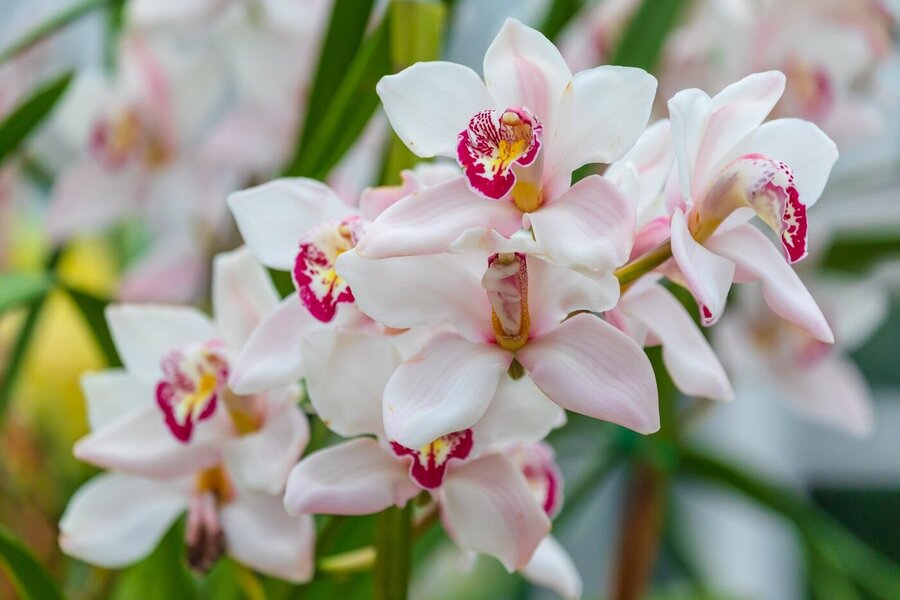
Characteristics of the Orchid Bonsai Tree
Orchid bonsai trees have various distinguishing traits that make them special and appealing. The following are some of the important qualities of the orchid bonsai tree:
- Delicate Beauty: Orchid bonsai trees showcase the delicate and intricate beauty of orchids in miniature form. They feature elegant flowers with intricate shapes, vibrant colors, and captivating patterns. The delicate petals and intricate details of the blooms contribute to the overall charm of the orchid bonsai tree.
- Graceful Foliage: The foliage on orchid bonsai trees is beautiful, with thin, arching branches and luscious, green leaves. The foliage compliments the blooms and contributes to the overall appearance of the tree. The size and form of the leaves might vary depending on the orchid type.
- Miniature Size: The tiny scale of bonsai trees, particularly orchid bonsai, is one of its distinguishing features. Orchid bonsai trees are precisely trained and trimmed to keep their compact form, making them ideal for exhibition on tabletops or shelves.
- Intricate Root System: Orchid bonsai trees often feature intricate and fascinating root systems. The exposed roots are carefully arranged and displayed, adding to the artistic appeal of the tree. The roots may grow over rocks or driftwood, creating a natural and visually appealing composition.
- Longevity: Orchid bonsai trees may have a lengthy lifespan if correctly maintained. Some varieties of orchid are renowned for their resilience and adaptability, making them ideal for bonsai care. If tended for and maintained properly, an orchid bonsai tree can be a valued companion for many years.
- Seasonal Blooms: During their flowering season, orchid bonsai trees can yield exquisite blossoms. The duration and frequency of flowering are dependent on the species of orchid. The blossoms can range from delicate and fragrant to assertive and showy, enhancing the bonsai tree’s natural attractiveness.
- Artistic Expression: Orchid bonsai trees allow for artistic expression and creativity. Bonsai enthusiasts can shape and style the tree, incorporating their own artistic vision and preferences. The combination of the orchid’s natural beauty and the artistry of bonsai techniques results in a captivating and unique living sculpture.
The characteristics of orchid bonsai trees contribute to their allure and appeal. Their delicate beauty, graceful foliage, miniature size, intricate roots, longevity, seasonal blooms, and artistic expression make them highly sought after among bonsai enthusiasts and orchid lovers alike.
How to Grow an Orchid Bonsai Tree
Growing an orchid bonsai tree requires careful attention and specific techniques to ensure its health and beauty. Here are the general steps to growing an orchid bonsai tree:
1. Select the Orchid Species: Choose an orchid species that is suitable for bonsai cultivation. Popular choices include Phalaenopsis, Dendrobium, Cymbidium, and Oncidium. Consider factors such as the orchid’s growth habit, flower color, and overall aesthetics.
2. Choose the Right Container: Select a shallow container or bonsai pot with good drainage. The size of the container should be appropriate for the root system of the orchid and allow for future growth. It’s essential to choose a container that complements the overall design and aesthetics of the orchid bonsai tree.
3. Provide Proper Light: Orchids require adequate light for healthy growth and blooming. Place your orchid bonsai tree in a location where it can receive bright, indirect light. Avoid direct sunlight, as it can scorch the leaves and flowers. Some orchid species have specific light requirements, so research the needs of your chosen orchid variety.
4. Maintain Optimal Temperature and Humidity: Orchids flourish in specified temperature and humidity conditions. Most orchid bonsai trees prefer temperatures ranging from 60 to 80°F (15 to 27°C) during the day and somewhat colder temps at night. Humidity values of 40-70% are normally appropriate. To enhance humidity, use a humidifier, a tray of water, or spray the orchid.
5. Water Properly: Orchids have unique watering needs. Water your orchid bonsai tree thoroughly when the potting medium feels dry, but avoid overwatering. Allow excess water to drain from the container to prevent root rot. Orchids prefer a slightly moist environment, but they should not be sitting in water.
Fertilize Regularly: Feed your orchid bonsai tree with a balanced orchid fertilizer according to the instructions on the package. Apply the fertilizer at a diluted strength every two to four weeks during the growing season. Reduce or stop fertilization during the dormant period.
6. Prune and Shape: Prune the orchid bonsai tree to maintain its desired shape and size. Remove dead or damaged leaves, flowers, or branches. Use bonsai pruning techniques to shape the tree, maintaining balance and aesthetics. Be careful not to overprune, as orchids require some foliage to photosynthesize and produce energy.
7. Repot when Necessary: Orchids generally require repotting every one to two years. Repot the orchid bonsai tree when the potting medium starts to break down or when the roots outgrow the container. Use a well-draining orchid mix suitable for the specific orchid species.
8. Prevent Pests and Diseases: Check your orchid bonsai tree frequently for pests such as aphids, mealybugs, or spider mites. If pests are discovered, take early action to eradicate them using the proper organic or chemical measures. Take the appropriate steps to stop the spread of any illnesses, such as fungal or bacterial infections, by keeping an eye out for them on the tree.
9. Provide Winter Care: Some orchid species require a period of cooler temperatures and reduced watering during the winter to initiate blooming. Research the specific winter care requirements for your chosen orchid species and adjust watering and temperature accordingly.
Remember that different orchid species may have specific care requirements, so it’s essential to research the specific needs of your orchid bonsai tree. Regular monitoring, observation, and adjustment of care practices will help ensure the health and vitality of your orchid bonsai tree.
Benefits of the Orchid Bonsai Tree
The orchid bonsai tree has various advantages that make it a popular option among bonsai and orchid aficionados. The following are some of the primary advantages of owning an orchid bonsai tree:
Aesthetic Beauty: Orchid bonsai trees are admired for their delicate and intricate beauty. The miniature size and artistic shaping of the tree enhance its visual appeal, making it a captivating addition to any space. The vibrant and elegant flowers of orchids add a touch of natural beauty and grace.
Stress Relief and Relaxation: Caring for an orchid bonsai tree can be a therapeutic and calming activity. The process of nurturing the tree, observing its growth, and tending to its needs can provide a sense of relaxation and stress relief. The presence of nature indoors, through the orchid bonsai tree, can create a peaceful ambiance.
Indoor Air Purification: Orchids, like many other plants, contribute to improving indoor air quality. They help filter and purify the air by absorbing pollutants and releasing oxygen. The presence of an orchid bonsai tree can contribute to a healthier indoor environment.
Symbolic Significance: Orchids have symbolic meanings associated with beauty, love, elegance, and spiritual growth in various cultures. Having an orchid bonsai tree can serve as a reminder of these qualities and values, bringing positive energy and symbolism into your space.
Educational Experience: Growing and caring for an orchid bonsai tree allows you to learn more about orchids, their growth tendencies, and their special maintenance requirements. It may be a great educational experience that can broaden your knowledge of plants and gardening.
Conversation Starter: The unique beauty and artistic presentation of an orchid bonsai tree often attract attention and spark conversations. It can serve as a focal point and a topic of discussion among guests, friends, and family, creating a connection and sharing the joy of nature.
Sense of Achievement: Successfully growing and maintaining an orchid bonsai tree can be a source of pride and accomplishment. It requires patience, dedication, and care to nurture the tree and witness its growth and blooms. The sense of achievement derived from creating and maintaining a beautiful living artwork can be immensely fulfilling.
Longevity: Orchid bonsai trees, with proper care, can have a long lifespan. Unlike cut flowers that wither after a short period, an orchid bonsai tree can be enjoyed for years, becoming a cherished companion and a part of your living space.
The benefits of an orchid bonsai tree go beyond its aesthetic appeal, offering therapeutic, symbolic, educational, and rewarding experiences. It provides an opportunity to connect with nature, enhance indoor environments, and cultivate a sense of tranquility and beauty.
Styling and Design of the Orchid Bonsai Tree
The styling and design of an orchid bonsai tree play a crucial role in showcasing its natural beauty and artistic expression. Here are some common styling techniques and design considerations for orchid bonsai trees:
Selecting the Right Container: Choose a shallow and well-proportioned container or bonsai pot that complements the size and style of the orchid bonsai tree. Consider the color and texture of the container to create a harmonious visual balance.
Branch and Stem Placement: Orchid bonsai trees typically have slender stems and branches that can be gently manipulated and shaped. Use wire or clips to guide the growth of branches and stems, creating an aesthetically pleasing structure. Consider the natural growth habits of the orchid species and aim for a balanced, harmonious arrangement.
Cascading or Upright Style: Decide on the overall style of the orchid bonsai tree. The cascading style features branches and flowers that flow gracefully downward, creating a waterfall-like effect. The upright style emphasizes vertical growth with a central trunk and upward-reaching branches. Choose a style that complements the natural growth pattern of the orchid species and aligns with your artistic vision.
Wiring and Training: Carefully use aluminum or copper wire to guide the growth of branches and create desired shapes. Be gentle to avoid damaging the delicate orchid stems. Over time, the wire can be removed once the branches have set in the desired position. Training the orchid bonsai tree through careful wiring and shaping is an ongoing process to maintain its desired form.
Displaying Air Roots: Orchids often have distinctive air roots that can add visual interest to the design. Instead of hiding or trimming them, incorporate the air roots into the overall composition. Position them gracefully over rocks or cascading down the container to create a natural and captivating effect.
Companion Plants and Accents: Consider adding complementary companion plants or accents to enhance the overall display. Select smaller plants or moss that thrive in similar conditions and do not overshadow the orchid bonsai tree. These additional elements can provide texture, color variation, and a more natural, landscape-like appearance.
Blooming Focus: Emphasize the beauty of the orchid blooms by positioning them as focal points in the design. Arrange branches and stems to frame and showcase the flowers. Ensure adequate space and light for the blooms to fully open and be appreciated.
Balance and Proportion: Aim for visual balance and proportion in the overall design. Distribute branches and foliage evenly to create a sense of harmony. Avoid overcrowding or creating imbalanced shapes. Step back and evaluate the composition from different angles to ensure a visually pleasing arrangement.
Remember, styling and designing an orchid bonsai tree is a creative and artistic process. It requires patience, experimentation, and a keen eye for aesthetics. Allow the natural beauty of the orchid to guide your design choices while incorporating your own artistic vision to create a unique and captivating display.
How to Care for and Maintain Orchid Bonsai Tree
Caring for and maintaining an orchid bonsai tree is essential to ensuring its health, vitality, and longevity. Here are some key care tips to keep your orchid bonsai tree thriving:
- Light and Temperature: To grow, orchids require strong, indirect light. Put your orchid bonsai tree somewhere where it will get filtered sunshine or brilliant, indirect light. Direct sunlight should be avoided since it might harm the foliage and blooms. Orchids prefer temperatures ranging from 60 to 80°F (15 to 27°C) during the day and somewhat lower temps at night.
- Watering: Orchids have specific watering needs. Water your orchid bonsai tree when the potting medium feels dry to the touch. Use room-temperature water and thoroughly soak the potting medium until water drains out of the bottom of the container. Avoid overwatering or letting the roots sit in standing water, as this can lead to root rot. Allow the potting medium to partially dry out between watering.
- Humidity: Orchids thrive in a humid environment. Increase the humidity around your orchid bonsai tree by placing it on a tray filled with water and pebbles or using a room humidifier. Alternatively, mist the leaves with water occasionally to provide some moisture. Aim for humidity levels of 40–70%.
- Potting Medium: Orchids require a potting media that drains well and permits air circulation around the roots. To make a suitable growth medium, use a specific orchid mix or a combination of bark, sphagnum moss, and perlite. When the potting media degrades or the roots overrun the container, repot your orchid bonsai tree.
- Fertilization: Feed your orchid bonsai tree with a balanced orchid fertilizer. Use a diluted fertilizer solution at half the recommended strength and apply it every two to four weeks during the growing season. Reduce or stop fertilization during the dormant period. Follow the package instructions for the specific fertilizer you are using.
- Pruning and Trimming: Regularly inspect your orchid bonsai tree for dead, damaged, or yellowing leaves, flowers, or stems. Prune these parts using clean, sharp pruning shears to maintain the tree’s health and appearance. Remove any overcrowded or crossing branches to improve air circulation and prevent disease.
- Repotting: Orchid bonsai trees typically require repotting every one to two years. Repot the tree when the potting medium starts to break down or the roots outgrow the container. Choose a slightly larger pot with good drainage and use fresh orchid mix. Be gentle when handling the roots to avoid damage.
- Pest and Disease Control: Regularly examine your orchid bonsai tree for common parasites such as aphids, mealybugs, and spider mites. As soon as you discover any vermin, address them with the appropriate organic or chemical remedies. Take the necessary precautions to prevent the spread of infectious diseases, such as fungal and bacterial infections.
- Winter Care: Some orchid species require a period of cooler temperatures and reduced watering during the winter to initiate blooming. Research the specific winter care requirements for your orchid bonsai tree and adjust watering and temperature accordingly.
- Regular Maintenance: Stay observant and attentive to the needs of your orchid bonsai tree. Monitor its growth, observe any changes in leaves or flowers, and adjust care practices accordingly. Regularly clean the leaves to remove dust and debris that can hinder their ability to photosynthesize.
By following these maintenance instructions and giving your orchid bonsai tree the attention it requires, you can appreciate its beauty for many years and ensure its health. Remember that specific care requirements may vary depending on the orchid species, so it is essential to research and comprehend the particular needs of your bonsai orchid plant. With proper care and maintenance, your orchid bonsai tree can flourish, produce beautiful blossoms, and bring you pleasure as a captivating living work of art.
Orchid Bonsai Tree Care sheet
| Aspect | Care Tips |
| Watering | – Water when the potting medium is partially dry |
| – Avoid overwatering and standing water | |
| Light | – Provide bright, indirect light |
| – Avoid direct sunlight, which can damage the leaves | |
| Temperature | – Maintain temperatures between 60-80°F (15-27°C) |
| Humidity | – Increase humidity with trays of water and pebbles |
| – Use a room humidifier or mist the leaves | |
| Pruning | – Remove dead, damaged, or yellowing leaves and stems |
| – Improve air circulation by pruning overcrowded branches | |
| Pinching | – Pinch back new growth to encourage branching and compactness |
| Fertilization | – Use a balanced orchid fertilizer |
| – Apply at half the recommended strength every 2-4 weeks | |
| Repotting | – Repot every 1-2 years or when the roots outgrow the container |
| – Use fresh orchid mix and a slightly larger pot with drainage | |
| Wiring and Shaping | – Gently wire and shape branches for desired design |
| – Be careful not to damage the delicate orchid stems | |
| Pest and Disease Control | – Regularly inspect for pests and treat with appropriate controls |
| – Monitor for signs of diseases and take preventive measures | |
| Winter Care | – Adjust watering and temperature based on species’ requirements |
| Regular Maintenance | – Clean leaves to remove dust and debris |
| – Monitor growth and adjust care practices as needed |
Remember to adapt these care tips to the specific requirements of your orchid bonsai tree species. Regular observation and care will help keep your orchid bonsai tree healthy and thriving.
Conclusion
Orchid bonsai trees offer a captivating blend of nature’s beauty and the artistry of bonsai. With their enchanting blooms and graceful forms, they bring a touch of elegance and serenity to any space. By understanding their care requirements and appreciating their symbolic value, enthusiasts can embark on a rewarding journey of cultivating and nurturing these delicate living sculptures.
FAQ:
Q: What is an Orchid Bonsai Tree?
A: A miniature orchid plant trained in the art of bonsai.
Q: How do I care for an Orchid Bonsai Tree?
A: Provide indirect light, water when partially dry, maintain appropriate temperature and humidity, prune as needed, fertilize with orchid fertilizer, repot when necessary, wire and shape carefully, monitor for pests and diseases, and adjust care in winter.
Q: Can any orchid species be made into a bonsai tree?
A: Certain orchid species are more commonly used for bonsai due to their size, growth habits, and adaptability to bonsai techniques.
Q: How often should I water my Orchid Bonsai Tree?
A: Water when the potting medium is partially dry, avoiding overwatering.
Q: Can I display my Orchid Bonsai Tree indoors?
A: Yes, as long as it receives proper light and temperature conditions.
Q: How long do Orchid Bonsai Trees live?
A: With proper care, they can live for many years, but their lifespan varies.
Q: Can I propagate my Orchid Bonsai Tree?
A: Yes, through methods like division or back-bulb propagation, depending on the orchid species.
Q: How often do Orchid Bonsai Trees bloom?
A: Blooming frequency varies among species, environmental conditions, and the care provided.
Also Read:



